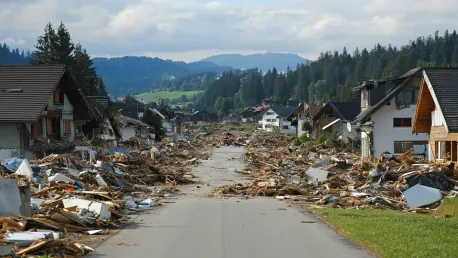In recent years, Americans have witnessed a troubling trend: natural disasters are becoming more frequent and severe, exacerbating the financial burden on individuals and the insurance industry. Hurricanes, wildfires, and extreme weather events have escalated in both number and intensity, largely attributable to climate change. As a result, the associated property damage costs have significantly impacted both homeowners and insurance companies. The financial toll from these disasters has compelled insurers to reevaluate their risk models and adjust coverage policies, leading to steep premium increases, particularly in high-risk areas. This article delves into the driving factors behind these changes, the resulting impact on policyholders, and the efforts by state regulators to mitigate the rise in premiums.
The Escalating Frequency of Natural Disasters
The United States has seen a dramatic increase in the frequency and severity of natural disasters in recent years. Acts of nature such as hurricanes, wildfires, and extreme weather patterns have become more common, a change that many attribute to the effects of climate change. The rise in these catastrophic events results in substantial property damage and financial losses for both homeowners and insurance companies. The financial burdens of these disasters are far-reaching, affecting various sectors of the economy and intensifying the challenges faced by insurers.
Insurance companies find themselves grappling with unprecedented challenges as they manage the financial aftermath of such catastrophes. The increased frequency of insurance claims has forced insurers to reassess their risk models and adjust their coverage policies accordingly. Often, this results in higher premiums for policyholders, with those in high-risk areas bearing the brunt of the increases. Additionally, the financial strain on insurance companies is compounded by the necessity to maintain solvency and ensure that they can cover future claims. Consequently, insurers are implementing stricter underwriting guidelines and raising premiums as they seek to manage their exposure to catastrophic losses more effectively.
Rising Insurance Premiums and Their Impact on Homeowners
Across the U.S., homeowners are experiencing significant increases in their insurance premiums due to natural disasters. In regions known for being prone to such events, such as coastal areas and wildfire zones, the rate hikes are particularly steep. These higher insurance costs place a heavy financial burden on homeowners, many of whom are struggling to afford necessary coverage. The situation is exceptionally dire for individuals in high-risk areas, where the cost of insurance can become prohibitively expensive. The rise in premiums has broader implications for the housing market, affecting not just individual homeowners but also potential buyers and overall market stability.
Higher insurance premiums can make it more difficult for potential homebuyers to secure mortgages, as lenders typically require adequate insurance coverage as a condition of approval. This obstacle can lead to a slowdown in the housing market, particularly in areas deemed high-risk by insurers. Some homeowners, in response to rising costs, are opting to reduce their coverage or forego insurance altogether, leaving them vulnerable to significant financial loss in the event of a disaster. This alarming trend underscores the need for affordable and accessible insurance options to ensure that homeowners are adequately protected against the increasing number of natural disasters.
State Regulators’ Efforts to Mitigate Rate Increases
State insurance commissioners play a crucial role in mitigating rate increases and protecting consumers from exorbitant insurance costs. These regulators work to balance the need for affordable insurance with the financial stability of insurance companies. In states like North Carolina, insurance commissioners are actively negotiating with insurance companies to limit premium hikes and ensure that homeowners can maintain their coverage. By implementing regulatory measures, state officials aim to create a fair insurance market that does not unduly burden consumers while safeguarding the solvency of insurers.
One approach taken by state regulators is the implementation of rate caps or requiring insurers to justify their rate increases through detailed filings. This process ensures that any premium hikes are based on actual risk assessments rather than arbitrary decisions. Additionally, some states are exploring the creation of state-sponsored insurance programs to provide coverage for high-risk properties that private insurers may be reluctant to cover. These regulatory efforts are essential in maintaining a stable insurance market and protecting consumers from excessive rate increases.
The Role of the Reinsurance Market
The reinsurance market plays a critical role in the insurance industry’s ability to manage catastrophic risks. Reinsurance companies provide coverage to primary insurers, helping them to spread the financial risk of large-scale disasters. When reinsurance rates increase due to the growing number of natural disasters, primary insurers often pass these costs on to their policyholders in the form of higher premiums. This interconnectedness means that major disasters in one part of the world can have a ripple effect on insurance costs globally, impacting homeowners everywhere.
To address these challenges, some insurers are exploring alternative risk transfer mechanisms, such as catastrophe bonds. Catastrophe bonds allow insurers to raise capital from investors to cover potential disaster-related losses, providing an innovative solution to stabilize the insurance market. These financial tools can offer more predictable coverage options for homeowners and help to ensure that insurers remain solvent in the face of increasing natural disaster frequency and severity. As the landscape of natural disaster risk evolves, insurers and reinsurance companies must continue to adapt and seek innovative solutions to provide sustainable protection for policyholders.
Special Insurance Programs for High-Risk Areas
In response to the challenges posed by natural disasters, some states have established special insurance programs to provide coverage for high-risk properties. Programs like the FAIR (Fair Access to Insurance Requirements) plans and Coastal Property Insurance Pools offer essential coverage for homeowners in areas that are not adequately served by private insurers. These programs are designed to ensure that homeowners in high-risk areas can obtain the necessary insurance coverage, even if private insurers are unwilling to provide it. By pooling resources and spreading the risk across a larger group of policyholders, these programs can offer more affordable and accessible coverage options.
While these state-sponsored programs provide a crucial safety net, they also face financial challenges due to the increasing frequency and severity of natural disasters. Ensuring the long-term viability of these programs requires ongoing support from state governments and collaboration with private insurers to develop sustainable risk management strategies. The importance of these programs cannot be overstated, as they offer vital protection for homeowners who might otherwise be left without coverage in the event of a disaster. In a changing climate, the ability to adapt and implement creative solutions will be key to protecting property and financial stability across the country.
Future Considerations for Homeowner’s Insurance
The future of homeowner’s insurance in the U.S. remains uncertain as the country continues to grapple with the increasing frequency and severity of natural disasters. The insurance industry must continue to adapt to these evolving challenges, balancing the need to remain solvent with the necessity of providing affordable coverage for homeowners. Policymakers, regulators, insurers, and consumers must work together to develop and implement innovative solutions that address both the financial burdens and risk management associated with natural disasters.
Looking forward, one key consideration is the role of technology in improving risk assessment and underwriting practices. Advances in data analytics, predictive modeling, and geographic information systems (GIS) can help insurers more accurately assess risks and tailor coverage accordingly. These technological advancements can also provide valuable insights for state regulators as they work to implement fair and effective policies. Ultimately, the goal is to create a more resilient insurance market that can withstand the impacts of climate change while ensuring that homeowners have access to necessary coverage.









